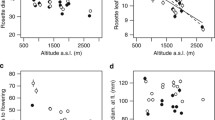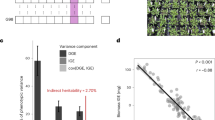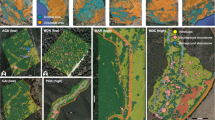Abstract
Owing to their sessile habits and trophic position within global ecosystems, higher plants display a sundry assortment of adaptations to the threat of predation. Unlike animals, nearly all higher plants can replace reproductive structures lost to predators by activating reserved growing points called axillary meristems. As the first step in a program aimed at defining the genetic architecture of the inflorescence replacement program (IRP) of Arabidopsis thaliana, we describe the results of a quantitative germplasm survey of developmental responses to loss of the primary reproductive axis. Eighty-five diverse accessions were grown in a replicated common garden and assessed for six life history traits and four IRP traits, including the number and lengths of axillary inflorescences present on the day that the first among them re-flowered after basal clipping of the primary inflorescence. Significant natural variation and high heritabilities were observed for all measured characters. Pairwise correlations among the 10 focal traits revealed a multi-dimensional phenotypic space sculpted by ontogenic and plastic allometries as well as apparent constraints and outliers of genetic interest. Cluster analysis of the IRP traits sorted the 85 accessions into 5 associations, a topology that establishes the boundaries within which the evolving Arabidopsis genome extends and restricts the species’ IRP repertoire to that observable worldwide.






Similar content being viewed by others
References
Aida M, Vernoux T, Furutani M, Traas J, Tasaka M (2002) Roles of PIN-FORMED1 and MONOPTEROS in pattern formation of the apical region of the Arabidopsis embryo. Development 129:3965–3974
Angenent GC, Stuurman J, Snowden KC, Koes R (2005) Use of Petunia to unravel plant meristem functioning. Trend Plant Sci 10:243–250
Aranzana MJ, Kim S, Zhao K, Bakker E, Horton M, Jakob K, Lister C, Molitor J, Shindo C, Tang C, Toomajian C, Traw B, Zheng H, Bergelson J, Dean C, Marjoram P, Nordborg M (2005) Genome-wide association mapping in Arabidopsis identifies previously known flowering time and pathogen resistance genes. PLoS Genet 1:531–539
Auldridge ME, Block A, Vogel JT, Dabney-Smith C, Mila I, Bouzayen M, Magallanes-Lundback M, DellaPenna D, McCarty DR, Klee HJ (2006) Characterization of three members of the Arabidopsis carotenoid cleavage dioxygenase family demonstrates the divergent roles of this multifunctional enzyme family. Plant J 45:982–993
Bakker EG, Stahl EA, Toomajian C, Nordborg M, Kreitman M, Bergelson J (2006) Distribution of genetic variation within and among local populations of Arabidopsis thaliana over its species range. Mol Ecol 15:1405–1418
Beemster GT, Baskin TI (1998) Analysis of cell division and elongation underlying the developmental acceleration of root growth in Arabidopsis thaliana. Plant Physiol 116:1515–1526
Beemster GT, De Vusser K, De Tavernier E, De Bock K, Inze D (2002) Variation in growth rate between Arabidopsis ecotypes is correlated with cell division and A-type cyclin-dependent kinase activity. Plant Physiol 129:854–864
Bennett M, Cullimore J (1990) Expression of three plant glutamine synthetase cDNA in Escherichia coli—formation of catalytically active isoenzymes, and complementation of a glnA mutant. Eur J Biochem 193:319–324
Bennett T, Leyser O (2006) Something on the side: axillary meristems and plant development. Plant Mol Biol 60:843–854
Bennett T, Sieberer T, Willett B, Booker J, Luschnig C, Leyser O (2006) The Arabidopsis MAX pathway controls shoot branching by regulating auxin transport. Curr Biol 16:553–563
Berg R (1960) The ecological significance of correlation pleiades. Evolution 14:171–180
Bergelson J, Stahl E, Dudek S, Kreitman M (1998) Genetic variation within and among populations of Arabidopsis thaliana. Genetics 148:1311–1323
Beveridge C (2006) Advances in the control of axillary bud outgrowth: sending a message. Curr Opin Plant Biol 9:35–40
Beveridge CA, Ross JJ, Murfet IC (1996) Branching in pea—action of genes rms3 and rms4. Plant Physiol 110:859–865
Beveridge CA, Symons GM, Murfet IC, Ross JJ, Rameau C (1997) The rms1 mutant of pea has elevated indole-3-acetic acid levels and reduced root-sap zeatin riboside content but increased branching controlled by graft-transmissible signal(s). Plant Physiol 115:1251–1258
Beveridge CA, Weller JL, Singer SR, Hofer JM (2003) Axillary meristem development. Budding relationships between networks controlling flowering, branching, and photoperiod responsiveness. Plant Physiol 131:927–934
Bidart-Bouzat MG (2004) Herbivory modifies the lifetime fitness response of Arabidopsis thaliana to elevated CO2. Ecology 85:297–303
Bidart-Bouzat MG, Portnoy S, Delucia EH, Paige KN (2004) Elevated CO2 and herbivory influence trait integration in Arabidopsis thaliana. Ecol Lett 7:837–847
Blows MW, Hoffmann AA (2005) A reassessment of genetic limits to evolutionary change. Ecology 86:1371–1384
Booker J, Auldridge M, Wills S, McCarty D, Klee H, Leyser O (2004) MAX3/CCD7 is a carotenoid cleavage dioxygenase required for the synthesis of a novel plant signaling molecule. Curr Biol 14:1232–1238
Booker J, Sieberer T, Wright W, Williamson L, Willett B, Stirnberg P, Turnbull C, Srinivasan M, Goddard P, Leyser O (2005) MAX1 encodes a cytochrome P450 family member that acts downstream of MAX3/4 to produce a carotenoid-derived branch-inhibiting hormone. Dev Cell 8:443–449
Borevitz JO, Nordborg M (2003) The impact of genomics on the study of natural variation in Arabidopsis. Plant Physiol 132:718–725
Boss PK, Bastow RM, Mylne JS, Dean C (2004) Multiple pathways in the decision to flower: enabling, promoting, and resetting. Plant Cell 16(Suppl):S18–S31
Camara MD, Ancell CA, Pigliucci M (2000) Induced mutations: a novel tool to study phenotypic integration and evolutionary constraints in Arabidopsis thaliana. Evol Ecol Res 2:1009–1029
Clarke JH, Mithen R, Brown JK, Dean C (1995) QTL analysis of flowering time in Arabidopsis thaliana. Mol Gen Genet 248:278–286
Cline M (1991) Apical dominance. Bot Rev 57:318–358
Doebley J, Stec A, Hubbard L (1997) The evolution of apical dominance in maize. Nature 386:485–488
Doust A (2007) Architectural evolution and its implications for domestication in grasses. Ann Bot (Lond) 100:941–950
Doust AN, Devos KM, Gadberry MD, Gale MD, Kellogg EA (2004) Genetic control of branching in foxtail millet. Proc Natl Acad Sci USA 101:9045–9050
Ehrenreich IM, Stafford PA, Purugganan MD (2007) The genetic architecture of shoot branching in Arabidopsis thaliana: a comparative assessment of candidate gene associations vs. quantitative trait locus mapping. Genetics 176:1223–1236
Emery R, Longnecker N, Atkins C (1998) Branch development in Lupinus angustifolius L. II. Relationship with endogenous ABA, IAA and cytokinins in axillary and main stem buds. J Exp Bot 49:555–652
Erickson RO, Sax KB (1956) Elemental growth rate of the primary root of Zea mays. Proc Am Phil Soc 100:487–498
Foo E, Bullier E, Goussot M, Foucher F, Rameau C, Beveridge CA (2005) The branching gene RAMOSUS1 mediates interactions among two novel signals and auxin in pea. Plant Cell 17:464–474
Grbic B, Bleecker A (2000) Axillary meristem development in Arabidopsis thaliana. Plant J 21:215–223
Griffith C, Kim E, Donohue K (2004) Life-history variation and adaptation in the historically mobile plant Arabidopsis thaliana (Brassicaceae) in North America. Am J Bot 91:837–849
Hallauer AR, Miranda JB (1981) Quantitative genetics in maize breeding, 2nd edn. Iowa State University Press, Ames
Hempel FD, Feldman LJ (1994) Bi-directional inflorescence development in Arabidopsis thaliana—acropetal initiation of flowers and basipetal initiation of paraclades. Planta 192:276–286
Institute SAS (1998) SAS/STAT User’s Guide, RElease 6.0, 3rd edn. SAS Institute Inc, Cary, NC
Johnson X, Brcich T, Dun EA, Goussot M, Haurogne K, Beveridge C, Rameau C (2006) Branching genes are conserved across species. Genes controlling a novel signal in pea are coregulated by other long-distance signals. Plant Physiol 142:1014–1026
Jorgensen RA, Que Q, Stam M (1999) Do unintended antisense transcripts contribute to sense cosuppression in plants? [letter; comment]. Trends Genet 15:11–12
Juenger T, Purugganan M, Mackay TF (2000) Quantitative trait loci for floral morphology in Arabidopsis thaliana. Genetics 156:1379–1392
Karlsson BH, Sills GR, Nienhuis J (1993) Effects of photoperiod and vernalization on the number of leaves at flowering in 32 Arabidopsis thaliana (Brassicaceae) ecotypes. Am J Bot 80:646–648
Komatsu K, Maekawa M, Ujiie S, Satake Y, Furutani I, Okamoto H, Shimamoto K, Kyozuka J (2003) LAX and SPA: major regulators of shoot branching in rice. Proc Natl Acad Sci USA 100:11765–11770
Koornneef M, Alonso-Blanco C, Vreugdenhil D (2004) Naturally occurring genetic variation in Arabidopsis thaliana. Annu Rev Plant Physiol Plant Mol Biol 55:141–172
Kowalski SP, Lan TH, Feldmann KA, Paterson AH (1994) QTL mapping of naturally-occurring variation in flowering time of Arabidopsis thaliana. Mol Gen Genet 245:548–555
Kuittinen H, Sillanpää MJ, Savolainen O (1997) Genetic basis of adaptation: flowering time in Arabidopsis thaliana. TAG Theor Appl Genet V95:573–583
Kurata N, Miyoshi K, Nonomura K, Yamazaki Y, Ito Y (2005) Rice mutants and genes related to organ development, morphogenesis and physiological traits. Plant Cell Physiol 46:48–62
Lempe J, Balasubramanian S, Sureshkumar S, Singh A, Schmid M, Weigel D (2005) Diversity of flowering responses in wild Arabidopsis thaliana strains. PLoS Genet 1:109–118
Leyser O (2003) Regulation of shoot branching by auxin. Trends Plant Sci 8:541–545
Leyser O (2005) The fall and rise of apical dominance. Curr Opin Genet Dev 15:468–471
Leyser O (2006) Dynamic integration of auxin transport and signalling. Curr Biol 16:R424–R433
Leyser O, Day S (2003) Mechanisms in plant development. Blackwell, Oxford
Leyser HM, Pickett FB, Dharmasiri S, Estelle M (1996) Mutations in the AXR3 gene of Arabidopsis result in altered auxin response including ectopic expression from the SAUR-AC1 promoter. Plant J 10:403–413
Lincoln C, Britton JH, Estelle M (1990) Growth and development of the axr1 mutants of Arabidopsis. Plant Cell 2:1071–1080
Long J, Barton M (2000) Initiation of axillary and floral meristems in Arabidopsis. Dev Biol 218:341–353
McSteen P, Leyser O (2005) Shoot branching. Annu Rev Plant Biol 56:353–374
Mitchell-Olds T (1996) Genetic constraints on life-history evolution: quantitative-trait loci influencing growth and flowering in Arabidopsis thaliana. Evolution 50:140–145
Mitchell-Olds T, Schmitt J (2006) Genetic mechanisms and evolutionary significance of natural variation in Arabidopsis. Nature 441:947–952
Mode CJ, Robinson HF (1959) Pleiotropism and the genetic variance and covariance. Biometrics 15:518–537
Morris SE, Turnbull CG, Murfet IC, Beveridge CA (2001) Mutational analysis of branching in pea. Evidence that Rms1 and Rms5 regulate the same novel signal. Plant Physiol 126:1205–1213
Mouchel CF, Briggs GC, Hardtke CS (2004) Natural genetic variation in Arabidopsis identifies BREVIS RADIX, a novel regulator of cell proliferation and elongation in the root. Genes Dev 18:700–714
Napoli C (1996) Highly branched phenotype of the petunia dad1-1 mutant is reversed by grafting. Plant Physiol 111:27–37
Napoli CA, Ruehle J (1996) New mutations affect meristem growth and potential in Petunia hybrida Vilm. J Hered 87:371–377
Napoli CA, Beveridge CA, Snowden KC (1999) Reevaluating concepts of apical dominance and the control of axillary bud outgrowth. Curr Top Dev Biol 44:127–169
Nishikawa S, Zinkl GM, Swanson RJ, Maruyama D, Preuss D (2005) Callose (beta-1, 3 glucan) is essential for Arabidopsis pollen wall patterning, but not tube growth. BMC Plant Biol 5:22
Nordborg M, Borevitz JO, Bergelson J, Berry CC, Chory J, Hagenblad J, Kreitman M, Maloof JN, Noyes T, Oefner PJ, Stahl EA, Weigel D (2002) The extent of linkage disequilibrium in Arabidopsis thaliana. Nat Genet 30:190–193
Nordborg M, Hu TT, Ishino Y, Jhaveri J, Toomajian C, Zheng H, Bakker E, Calabrese P, Gladstone J, Goyal R, Jakobsson M, Kim S, Morozov Y, Padhukasahasram B, Plagnol V, Rosenberg NA, Shah C, Wall JD, Wang J, Zhao K, Kalbfleisch T, Schulz V, Kreitman M, Bergelson J (2005) The pattern of polymorphism in Arabidopsis thaliana. PLoS Biol 3:e196
Olson E, Miller R (1958) Morphological integration. University of Chicago Press, Chicago, IL
Ongaro V, Leyser O (2008) Hormonal control of shoot branching. J Exp Bot 59:67–74
Otsuga D, DeGuzman B, Prigge MJ, Drews GN, Clark SE (2001) REVOLUTA regulates meristem initiation at lateral positions. Plant J 25:223–236
Paige KN (1992) Overcompensation in response to mammalian herbivory: from mutualistic to antagonistic interactions. Ecology 73:2076–2085
Paige KN (1999) Regrowth following ungulate herbivory in scarlet gilia, Ipomopsis aggregata: geographic evidence for overcompensation. Oecologia 118:316–323
Perez Callejon E, Casamayor A, Pujol G, Clua E, Ferrer A, Arino J (1993) Identification and molecular cloning of two homologues of protein phosphatase-X from Arabidopsis thaliana. Plant Mol Biol 23:1177–1185
Pigliucci M (2003) Selection in a model system: Ecological genetics of flowering time in Arabidopsis thaliana. Ecology (Washington DC) 84:1700–1712
Pigliucci M (2007) Finding the way in phenotypic space: the origin and maintenance of constraints on organismal form. Ann Bot (Lond) 100:433–438
Pigliucci M, Preston K (eds) (2004) Phenotypic integration. Oxford University Press, Oxford
Pigliucci M, Schlichting CD (1998) Phenotypic evolution: a reaction norm perspective. Sinauer Associates, Inc., Sunderland, MA
Pouteau S, Ferret V, Gaudin V, Lefebvre D, Sabar M, Zhao G, Prunus F (2004) Extensive phenotypic variation in early flowering mutants of Arabidopsis. Plant Physiol 135:201–211
Rameau C, Murfet IC, Laucou V, Floyd RS, Morris SE, Beveridge CA (2002) Pea rms6 mutants exhibit increased basal branching. Physiol Plant 115:458–467
Reintanz B, Lehnen M, Reichelt M, Gershenzon J, Kowalczyk M, Sandberg G, Godde M, Uhl R, Palme K (2001) bus, A bushy arabidopsis cyp79f1 knockout mutant with abolished synthesis of short-chain aliphatic glucosinolates. Plant Cell 13:351–367
Roff DA, Fairbairn DJ (2007) The evolution of trade-offs: where are we? J Evol Biol 20:433–447
Schmitz G, Tillmann E, Carriero F, Fiore C, Cellini F, Theres K (2002) The tomato blind gene encodes a MYB transcription factor that controls the formation of lateral meristems. Proc Natl Acad Sci USA 99:1064–1069
Schumacher K, Schmitt T, Rossberg M, Schmitz G, Theres K (1999) The Lateral suppressor (Ls) gene of tomato encodes a new member of the VHIID protein family. Proc Natl Acad Sci USA 96:290–295
Searle SR (1971) Linear models. Wiley, New York, NY
Sharbel TF, Haubold B, Mitchell-Olds T (2000) Genetic isolation by distance in Arabidopsis thaliana: biogeography and postglacial colonization of Europe. Mol Ecol 9:2109–2118
Shimizu-Sato S, Mori H (2001) Control of outgrowth and dormancy in axillary buds. Plant Physiol 127:1405–1413
Simons JL, Napoli CA, Janssen BJ, Plummer K, Snowden KC (2007) Analysis of the DECREASED APICAL DOMINANCE genes of petunia in the control of axillary branching. Plant Physiol 143:697–706
Snowden KC, Napoli CA (2003) A quantitative study of lateral branching in petunia. Funct Plant Biol 30:987–994
Stafstrom J (1993) Axillary bud development in pea: apical dominance, growth cycles, hormonal regulation and plant architecture. In: Amasino R (ed) Cellular communication in plants. Academic Press, New York, pp 75–86
Stirnberg P, van De Sande K, Leyser HM (2002) MAX1 and MAX2 control shoot lateral branching in Arabidopsis. Development 129:1131–1141
Stirnberg P, Furner IJ, Leyser HMO (2007) MAX2 participates in an SCF complex which acts locally at the node to suppress shoot branching. Plant J 50:80–94
Tabachnick BG, Fidell L (2000) Using multivariate statistics, 4th edn. Allyn & Bacon, New York
Thimann K, Skoog F (1933) Studies on the growth hormone of plants. III. The inhibiting action of the growth substance on bud development. Proc Natl Acad Sci USA 19:714–716
Tonsor SJ, Alonso-Blanco C, Koornneef M (2005) Gene function beyond the single trait: natural variation, gene effects, and evolutionary ecology in Arabidopsis thaliana. Plant Cell Environ 28:2–20
Umehara M, Hanada A, Yoshida S, Akiyama K, Arite T, Takeda-Kamiya N, Magome H, Kamiya Y, Shirasu K, Yoneyama K, Kyozuka J, Yamaguchi S (2008) Inhibition of shoot branching by new terpenoid plant hormones. Nature 455:195–200
Ungerer MC, Halldorsdottir SS, Modliszewski JL, Mackay TF, Purugganan MD (2002) Quantitative trait loci for inflorescence development in Arabidopsis thaliana. Genetics 160:1133–1151
Utz HF (1998) PLABSTAT: a computer program for the statistical analysis of plant breeding experiments. Institute of Plant Breeding, Seed Science, and Population Genetics, University of Hohenheim, Stuttgart
Vesk P, Westoby M (2004) Funding the bud bank: a review of the costs of buds. Oikos 106:200–208
Weigel D, Nordborg M (2005) Natural variation in Arabidopsis. How do we find the causal genes? Plant Physiol 138:567–568
Weinig C, Stinchcombe JR, Schmitt J (2003a) Evolutionary genetics of resistance and tolerance to natural herbivory in Arabidopsis thaliana. Evolution Int J Org Evolution 57:1270–1280
Weinig C, Stinchcombe JR, Schmitt J (2003b) QTL architecture of resistance and tolerance traits in Arabidopsis thaliana in natural environments. Mol Ecol 12:1153–1163
Woo HR, Chung KM, Park J-H, Oh SA, Ahn T, Hong SH, Jang SK, Nam HG (2001) ORE9, an F-box protein that regulates leaf senescence in Arabidopsis. Plant Cell 13:1779–1790
Zhao K, Aranzana MJ, Kim S, Lister C, Shindo C, Tang C, Toomajian C, Zheng H, Dean C, Marjoram P, Nordborg M (2007) An Arabidopsis example of association mapping in structured samples. PLoS Genet 3:e4
Zou J, Chen Z, Zhang S, Zhang W, Jiang G, Zhao X, Zhai W, Pan X, Zhu L (2005) Characterizations and fine mapping of a mutant gene for high tillering and dwarf in rice (Oryza sativa L.). Planta 222:604–612
Acknowledgments
We thank Miranda Neuhaus, Melissa Pindel, Kirsten Grau and Lucy Kehinde for expert assistance with phenotyping plants and entering data for analysis; and, the Research Board of the University of Illinois at Urbana-Champaign for support.
Author information
Authors and Affiliations
Corresponding author
Additional information
Communicated by M. Kearsey.
Electronic supplementary material
Below is the link to the electronic supplementary material.
Rights and permissions
About this article
Cite this article
Sano, C.M., Bohn, M.O., Paige, K.N. et al. Heritable variation in the inflorescence replacement program of Arabidopsis thaliana . Theor Appl Genet 119, 1461–1476 (2009). https://doi.org/10.1007/s00122-009-1148-5
Received:
Accepted:
Published:
Issue Date:
DOI: https://doi.org/10.1007/s00122-009-1148-5




